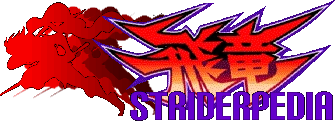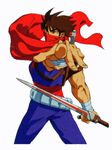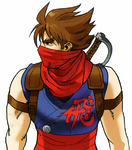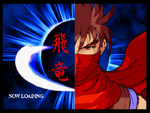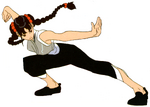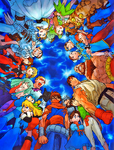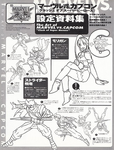Marvel vs. Capcom: Clash of Super Heroes (マーヴル VS. カプコン クラッシュ オブ スーパーヒーローズ) is the third installment in the Marvel vs. Capcom crossover fighting game series, and the first to expand Capcom's roster beyond the Street Fighter franchise. The game received a near-perfect Dreamcast port in 1999 and a watered-down PlayStation port in 2000. In the latter half of 2012 it was included as one of two titles in Marvel vs. Capcom: Origins, released for the the Xbox Live Arcade and PlayStation Network, including a number of upgrades like HD graphics, online play and Achievement/Trophy support.
Like its predecessors, the game is a 2-on-2 tag team fighting game where the player can freely switch between his/her two selected characters or use the second character for combined hyper attacks known as Variable Combinations. Most notable gameplay changes include the Special Partners system, a set of characters who are randomly selected every round, and can be called forth a limited number of times to do a quick assist attack; and the Duo Team Attack, in which both of the player characters can be used on-screen at the same time. Neither of these features returned for the sequel.
Story & Characters[]
The storyline is loosely based on the X-Men: Onslaught arc from the Marvel Comics continuity: following an incident in which mutant telepath Charles Xavier was forced to enter into the mind of Magneto, part of Magneto's anger slipped into Xavier's psyche, and after merging with Xavier's darkest emotions it spawned a powerful psychic entity known as Onslaught.[3]. The game expands on the story by having Xavier's conscience calling forth heroes from the Capcom universe in order to help stop him.[4]
The game has a total of 16 playable characters (the final boss becoming playable in home ports), plus 6 secret characters and 22 "Special Partners".
| Character List | |||
|---|---|---|---|
| Playable Characters | Special Partners | ||
| Marvel | Capcom | Marvel | Capcom |
| Captain America | Captain Commando | Colossus | Anita |
| Gambit | Chun-Li | Cyclops | Arthur |
| Hulk | Jin Saotome | Iceman | Devilot |
| Onslaught [Final Boss] | Mega Man | Jubilee | Lou |
| Spider-Man | Morrigan | Juggernaut | Michelle Heart |
| Venom | Ryu | Magneto | Pure & Fur |
| War Machine | Strider Hiryu | Psylocke | Saki |
| Wolverine | Zangief | Rogue | Shadow [Hidden] |
| Secret Characters | Sentinel [Hidden] | Ton Pooh | |
| "MSH-Performance" Hulk[5] | "Lilith-Mode" Morrigan[5] | Storm | Unknown Soldier |
| "High Speed" Venom[5] | Roll | Thor | |
| "Hyper Armor" War Machine[5] | Shadow Lady | U.S. Agent | |
Strider Hiryu[]
Strider Hiryu joined the roster of the game as one of its 15 playable characters, sporting a redesign created by Bengus, Capcom's premiere concept artist[1]. Hiryu's inclusion in the roster was main planner Atsushi Tomita's intention from the beginning, as he was a fan of the Arcade original in his youth and wanted to "ressurect" the character[1][6]. He soon became one of the more popular characters in the game, thanks to his powerful movelist: combining great speed, naturally-chaining combos and effective Hyper Combos, Hiryu became one of the perceived top tier picks in the game. In Japan, Hiryu ranked third place in a poll conducted by Capcom with a total of 1,283 votes, tailing behind Ryu (1,513) and Morrigan (1,534).[7]
While characters of both franchises aren't paired up as rivals in the game, Hiryu was paired up with Spider-Man for a promotional set of toys produced by ToyBiz. This would be the first (and certainly not the last) time in which both characters are paired-up in this series.
Official profile
- "The Striders are a modern day ninja force. He is the best of them" - English[8]
- "The strongest man in the Striders, a group of ninja living in modern times. His Light Sword Cypher cuts through darkness!" - Japanese[9]
Alternate Colors[]

|

|
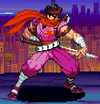
|
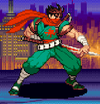
|
| Color 1 | Color 2 | PlayStation Extra Color 1 | PlayStation Extra Color 2 |
|---|
Hiryu's new design borrows from his look in the original manga, most noticeable in the long red scarf. This was the first time Hiryu uses it during a game (barring cutscenes in the NES Strider), with Bengus explaining that after seeing Tatsumi Wada's manga artwork and liking it, he decided that Hiryu's "fighting game version" would also sport it[1]. This updated look would become his staple design, used in all his future game appearances. Out of the 4 alternative colors, the PlayStation port-exclusive purple palette appears to be a reference to his original sprite's color scheme.
Hiryu's Movelist[]
- Main article: Marvel vs. Capcom/Movelist
Hiryu's moves are mostly original for the series, though they still pay homage to certain elements of the original Arcade game, such as the use of Options or wall-climbing. Most of Hiryu's techniques carry out a theme naming based on mythology, either being named after weapons (Gram, Excalibur, Ame-no-Murakumo) or concepts (Vajra, Ragnarok) from many different ancient mythologies.
Additional Notes & References[]
Details and references to the series can be seen in Hiryu's animations and winposes.
- Each character has a personal theme used during battle. "Theme of Strider Hiryu" is a remix of the Arcade game's first stage music, "Raid!". It also includes the intro fanfare (named "Defense Line") heard as the stage intro cinematic starts.
- The character select screen shows the series' logo next to the character's portraits. Hiryu and Mega Man are the only two whose logo differs depending on the game's region, Hiryu using the purple "Strider" logo from the Arcade game (
 ) in English, and the full Japanese logo in the original (
) in English, and the full Japanese logo in the original ( ).
). - Hiryu's ending is a homage and full recreation of the original Arcade ending: after defeating Onslaught, Hiryu leaves the area in his Glider, to jump down into the back of a whale as it swims in the ocean. The ending uses a remix of the arcade's ending theme, "Sara ni...", only heard in later revisions of the Arcade game.
- Hiryu's two seperate spoken lines from the Arcade Strider are referenced:
- "Take me to your boss!" is one of his after-match win quotes.
- "You are sending a toy into a battle?" is heard as a voice clip in some of Hiryu's win poses, albeit spoken in Japanese (きさまらにそんな玩具は必要ない).
- Conversely, Hiryu's spoken line from the ending of the Japanese version of Strider 2 is taken from Hiryu's ending in this game: Mission Accomplished - "Mission Complete" (任務完了Ninmu kanryō).
- Several of Hiryu's animations are very similar to animations seen in the Arcade game:
- Hiryu's MP attack is a perfectly horizontal slash, likely in reference to Hiryu's original slash animation. The crouching and jumping MP variants, as well as the "Gram" Special Move, all use the same animation. His sword slashes are all accompanied by the distinctive sound made by the Cypher in the original.
- While jumping, Hiryu performs the same iconic cartwheel motion he does when performing long jumps in the Arcade.
- Hiryu's back dash has him tumbling backwards in a similar manner to when he's hit in the Arcade game.
- When Hiryu is defeated (by either K.O. or Time Out), his body dissipates away using an almost identical animation and sound effect from the Arcade's death animation.
- One of Hiryu's intros has him flying into the screen with his Glider, a reference to the intro sequence from the Arcade's first stage.
- Another one of Hiryu's intros shows the Item Box used in the Arcade game to hold items. The intro has Hiryu open it with one slash, releasing a Dipodal Saucer from it which promptly walks away.
- One of Hiryu's win poses has him suddenly turning upside down and standing in the ceiling, a clear reference to the inverted gravity areas in both stage 3 and 5 of the original game.
- Besides his "Wall Climb" technique, Hiryu also uses the Arcade game's Climb Sickle in one of his ground throws.
- For some reason, Roll's three intro animations are parodies of Hiryu's: she enters the screen hanging upside-down from Beat (Hiryu's glider entrance), she kicks Eddie and makes him walk away (Hiryu opening the Item Box) and she enters on top of Rush (Hiryu entering on top of the Option B).
Ton Pooh[]

|

|
| Color 1 | Color 2 |
|---|
Ton Pooh appears as one of the Special Partners. When summoned, she jumps into the screen and does her signature attack: after doing a small leap forward, she spins around and delivers a back kick with an extended range which covers most of the screen. As she does so, she screams "Deadly Plasma Leg! Ha!" (必殺プラズマ脚!は!). She can be called to attack a total of 9 times.
Her alternate color is inspired by the gray-clothed boss fight from the original Arcade's final stage, also known as the "Mourning Dress Version" (喪服バージョン)[10]. While it seems there were doubts about using her due to the fact she was not the protagonist of the game[10], apparently her original appearance in Strider left a strong enough impression to allow for her inclusion.[11]
Neo St. Petersburg[]
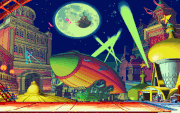
Neo St. Petersburg is Strider Hiryu's home stage in the game, inspired by the first level in the original Arcade. The stage is set in the red platforms from the initial area, overlooking the capital city and their various mosque buildings while several searchlights waves around in the background, much like in the original game. Original for this game is the inclusion of a zeppelin floating up in the center of the stage, bearing the Kazakh Federation's half-star symbol.
Two laser signs can be seen at times in the sky: the first writes "Казахскар CCP" (a misspelling of "Казахская ССР", Russian for "Kazakh SSR") while the second writes intermittently "A.D. 2048" and "санкций" (Russian for "sanctions"). The first two are direct references to the intro scroll that opens up the Arcade's first stage, while the third word is original for this game. The Third Moon can also be spotted high up in the sky, in front of the real moon.
Gallery[]
References[]
- ↑ 1.0 1.1 1.2 1.3 Capcom (March 10, 2014). "Capcom Legends Chapter 3: The Running Ninja from the Future, Hiryu!" (Japanese). Capcom's official site. Retrieved from Archive.org. Accessed November 14, 2020
- ↑ Paget, Mat (September 9, 2020). "Marvel Vs Capcom And More Arcade1Up Cabinets Available For Pre-Order" (English). gamespot.com. Accessed November , 2020
- ↑ Capcom (January 1998, CPS-2 Board). Marvel vs. Capcom: Clash of Super Heroes (English). Wolverine's ending
- ↑ Capcom (January 1998, CPS-2 Board). Marvel vs. Capcom: Clash of Super Heroes (English). Captain America's ending
- ↑ 5.0 5.1 5.2 5.3 Capcom. Official Marvel vs. Capcom website (Japanese). Hidden Character Appearances, Commands and Special Moves. Retrieved from Archive.org. Accessed November 17, 2011.
- ↑ Capcom (2014). "Launch Celebration Comments from Past Special-A Class Striders". Capcom's official Strider site (Japanese). Retrieved July 05, 2015.
- ↑ Capcom. Official Marvel vs. Capcom website (Japanese). "Marvel vs. Capcom" Character Popularity Contest Results!!. Retrieved from Archive.org. Accessed November 17, 2011.
- ↑ Capcom. Marvel vs. Capcom arcade flyer. The Arcade Flyer Archive. Accessed November 17, 2011.
- ↑ Capcom. Official Marvel vs. Capcom website (Japanese). Character Introduction - Strider Hiryu. Retrieved from Archive.org. Accessed November 17, 2011.
- ↑ 10.0 10.1 Capcom (1998). Secret File #18: Marvel vs. Capcom: Clash of Super Heroes (Japanese). Pg. 7
- ↑ Capcom. Official Marvel vs. Capcom website (Japanese). Support Characters Introduction. Retrieved from Archive.org. Accessed November 17, 2011.
